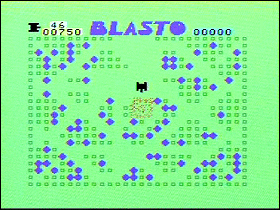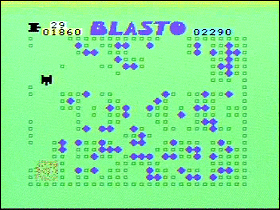 The Game: Piloting your mobile cannon around a cluttered playfield, you have but one task: clear the screen of mines, without blowing yourself up, in the time allotted. If you don’t clear the screen, or manage to detonate a mine so close to yourself that it takes you out, the game is over. If you do clear all the mines, you get a free chance to try it again. Two players can also try to clear the minefield simultaneously. (Texas Instruments, 1980)
The Game: Piloting your mobile cannon around a cluttered playfield, you have but one task: clear the screen of mines, without blowing yourself up, in the time allotted. If you don’t clear the screen, or manage to detonate a mine so close to yourself that it takes you out, the game is over. If you do clear all the mines, you get a free chance to try it again. Two players can also try to clear the minefield simultaneously. (Texas Instruments, 1980)
Memories: Programmed for TI by Milton Bradley‘s in-house video game group under contract, Blasto is an adaptation of an oscure 1978 B&W arcade game, and while the TI 99/4a has no problem replicating the game play, it has virtually no choice but to improve on the arcade Blasto‘s almost-nonexistent graphics and sound.
 Bob Harris, who would soon leave Milton Bradley and join the reinvigorated in-house pool of game designers and programmers at Magnavox (later North American Philips), coded this version of Blasto, and admits that somewhere along the development curve, the home version would’ve sported more than improved graphics – variations on game play were also tinkered with during development, but in the end, the license called for a straight-ahead port of the arcade game. That’s what TI users got – still enjoyable, but one wonders about some of the variations that we didn’t get to see…
Bob Harris, who would soon leave Milton Bradley and join the reinvigorated in-house pool of game designers and programmers at Magnavox (later North American Philips), coded this version of Blasto, and admits that somewhere along the development curve, the home version would’ve sported more than improved graphics – variations on game play were also tinkered with during development, but in the end, the license called for a straight-ahead port of the arcade game. That’s what TI users got – still enjoyable, but one wonders about some of the variations that we didn’t get to see…
 After Harris’ departure, Milton Bradley would continue serving as a kind of contractor for TI, though eventually the board game maker branched out and created the MBX peripheral, which added new capabilities and controllers to the TI 99/4a for gaming purposes. Milton Bradley also briefly distributed GCE’s innovative Vectrex console, and made a very brief attempt to get in on the massive Atari VCS software and peripheral market, without making much of a splash.
After Harris’ departure, Milton Bradley would continue serving as a kind of contractor for TI, though eventually the board game maker branched out and created the MBX peripheral, which added new capabilities and controllers to the TI 99/4a for gaming purposes. Milton Bradley also briefly distributed GCE’s innovative Vectrex console, and made a very brief attempt to get in on the massive Atari VCS software and peripheral market, without making much of a splash.
